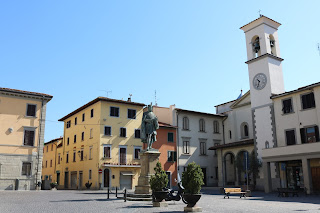Borgia pope’s ally used his power to benefit Milan
 |
| Cardinal Ascanio Sforza has been described as Machiavellian in his diplomatic skills |
He played a major part in the election of Rodrigo Borgia as Pope Alexander VI in the papal conclave of 1492 and served as Vice-Chancellor of the Holy Roman Church from 1492 until 1505.
Ascanio was the son of Francesco Sforza, Duke of Milan, and Bianca Maria Visconti. Two of his brothers, Galeazzo Maria Sforza and Ludovico Sforza, became Dukes of Milan, as did his nephew, Gian Galeazzo Sforza.
At the age of ten, Ascanio was named commendatory abbot of Chiaravalle and he was promised the red hat of a cardinal when he was in his teens. He was appointed Bishop of Pavia in 1479.
Pope Sixtus IV created him cardinal deacon of SS Vito e Modesto in March 1484. Pope Sixtus died in August before Ascanio’s formal ceremony of investiture had taken place and some of the cardinals objected to him participating in the conclave to elect the next pope.
Cardinal Rodrigo Borgia intervened on his behalf and Ascanio was received with all the rights of a cardinal. The conclave elected Giovanni Battista Cybo as Pope Innocent VIII.
 |
| Sforza played an important part in helping Rodrigo Borgia be elected as Pope |
Ascanio became so powerful he was virtually prime minister of the Holy See.
He arranged the marriage of Giovanni Sforza, his cousin, to Lucrezia Borgia, the pope’s illegitimate daughter, but the marriage was annulled four years later on the grounds of non consummation.
The friendship between Ascanio and Alexander VI came to an end when the French invaded Italy because the Sforza family had made a secret alliance with King Charles VIII of France. Ascanio tried to get the pope deposed along with several cardinals but the papal troops defeated the French. Once the Sforzas gave up their support of the French, Ascanio was received in the Vatican again, but his relationship with Alexander VI was never the same.
When Giovanni Borgia, the pope’s son, was stabbed to death, Ascanio was accused of the murder but he was quickly absolved by the pope.
After the French invaded Italy again in 1500, Ascanio’s brother, Ludovico Sforza, was imprisoned and Ascanio was taken to France where he was held captive for nearly two years.
| Andrea Sansovino's tomb for Ascanio was commissioned by Pope Julius II |
Ascanio became ill with the plague in May 1505 and died, aged 50, at his home near San Girolamo degli Schiavoni in Rome. He was buried the same evening with no ceremony because he had died of the plague.
Julius II commissioned Andrea Sansovino to erect a tomb for Cardinal Ascanio in the Cappella Maggiore of Santa Maria del Popolo with an inscription announcing that Julius II had forgotten Cardinal Ascanio’s honest opposition - ‘honestissimarum contentionum oblitus’.
Ascanio Sforza has been judged to have been both intelligent and Machiavellian, but to have remained dedicated to Milan and to his family.
In recent TV dramas about the Borgias, the role of Cardinal Ascanio Sforza has been played variously by the British actors, Clive Merrison, Peter Sullivan and Christian McKay.
 |
| Cremona's famous bell tower, il Torrazzo |
Cremona in Lombardy, where Ascanio Sforza was born, is famous for having the tallest bell tower in Italy, il Torrazzo, which measures more than 112 metres in height. The city is also well known for producing torrone, a type of nougat. It is thought the concoction of almonds, honey and egg whites was first created in the shape of il Torrazzo to mark the marriage of Ascanio’s parents, Bianca Maria Visconti and Francesco I Sforza, in 1441. To sample the many different types of torrone now made in Cremona, visit Negozio Sperlari in Via Solferino in the centre of the city.
 |
| The Church of Santa Maria del Popolo in Rome, where Ascanio Sforza is buried |
Ascanio Sforza’s tomb by Sansovino is in Santa Maria del Popolo, a minor basilica in Piazza del Popolo in Rome. The basilica was important during the Borgia era. When the Pope’s son, Giovanni Borgia, Duke of Gandia, was murdered in 1497 his body lay in state in the basilica for several days before being buried in the Borgia chapel. Vannozza dei Cattanei, former mistress of Alexander VI, and Ludovico Podocataro, the pope’s secretary and physician, were also buried there.
Also on this day:
1578: The death of Venetian Doge Sebastiano Venier
1585: The inauguration of the Teatro Olimpico in Vicenza
1768: The death of composer and teacher Nicola Porpora
1882: The birth of fraudstar Charles Ponzi
Home







